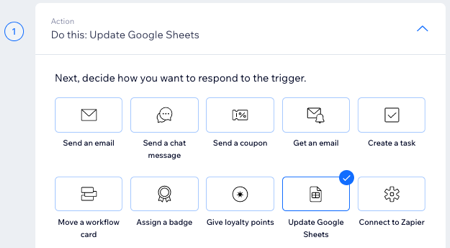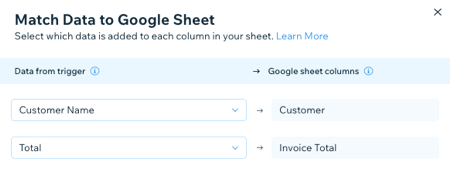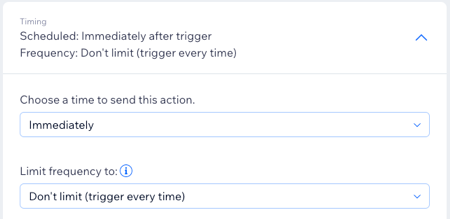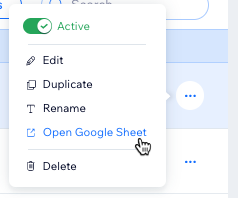Wix Automations: Sending Data to Google Sheets
6 min read
In this article
- Step 1 | Create a new automation and connect your Google account
- Step 2 | Connect a spreadsheet to your automation
- Step 3 | Match trigger data to the spreadsheet
- Step 4 | Choose the timing and activate the automation
- FAQs
This article refers to the previous automation builder. If you're not seeing this version, then see our article about the new version of the automation builder.
Create an automation that sends data to Google Sheets, such as form submissions or invoice details. This allows you to collaborate with people using Google Sheets without giving them access to your Wix dashboard.
Note:
The data you send to a spreadsheet is different depending on the app. For example, Wix Forms sends form submission data like Name and Email fields, and Wix Stores sends data like recent store orders.
Step 1 | Create a new automation and connect your Google account
To begin, create a new automation and choose Update Google Sheets as the action. Then connect your Google account so the automation can access the spreadsheet.
To create a new automation and connect your Google account:
- Go to Automations in your site's dashboard.
- Click + New Automation in the top right corner.
- Click + Start from Scratch.
- Give your automation a title and choose a trigger.
- Scroll down to the Action section and click Update Google Sheets.

- Click Connect Google Account.
- Select the relevant Google account.
- Click Allow.
Important:
When connecting your Google account, you are providing permissions for Wix to access your spreadsheet data. You can remove permissions at any time from your Google account.
If you remove Wix permissions, any automations that use Google Sheets will become disconnected and stop working. You can reset your Google permissions in an automation, but note that the trigger can't work retroactively or add any information that was "skipped" while the automation was disconnected.
Step 2 | Connect a spreadsheet to your automation
Next, connect the relevant spreadsheet to your automation. All spreadsheets in your connected Google account can be used in your automations. You can create new spreadsheets within Google Sheets and use these too.
Choose what you want to do:
Connect an existing spreadsheet to the automation
Create a new spreadsheet in Google Sheets and connect it
Step 3 | Match trigger data to the spreadsheet
Next, match the data from your chosen trigger to the correct columns in your spreadsheet. For example, if your trigger data includes customer and invoice total fields, you need to match that data to the "Customer" and "Invoice Total" spreadsheet columns.
To match your trigger data:
- Click Match Data to Sheet.

- Click the drop-downs under Data from trigger to match them to the Google sheet columns.
Note: If you need to make edits to column titles, do so within your Google spreadsheet and click Refresh Data at the bottom left to see these changes reflected. - Click Save.

Step 4 | Choose the timing and activate the automation
When you've matched the data to the spreadsheet columns, set the timing and frequency of the action.
To choose the timing and activate your automation:
- Click the Timing drop-down and set the timing and frequency:
- Choose a time to send this action: Click the drop-down and choose when the action occurs. You can choose to have the automation trigger immediately or set a custom time.
- Limit frequency to: Click the drop-down and choose how many times the same trigger can cause the action to occur.

- (Optional) Click + Add an Action to add another action that takes place following the trigger.
- Click Activate to publish the automation.
Tip:

Click the More Actions icon  next to an existing automation in the Automations dashboard and Open Google Sheet to quickly view the Google spreadsheet.
next to an existing automation in the Automations dashboard and Open Google Sheet to quickly view the Google spreadsheet.
 next to an existing automation in the Automations dashboard and Open Google Sheet to quickly view the Google spreadsheet.
next to an existing automation in the Automations dashboard and Open Google Sheet to quickly view the Google spreadsheet.
FAQs
Here are some common questions about Google Sheets automations:
I've edited the columns in my Google Sheet - how do I rematch the data?
What happens if I edit my Google Sheets permissions?



 .
.

